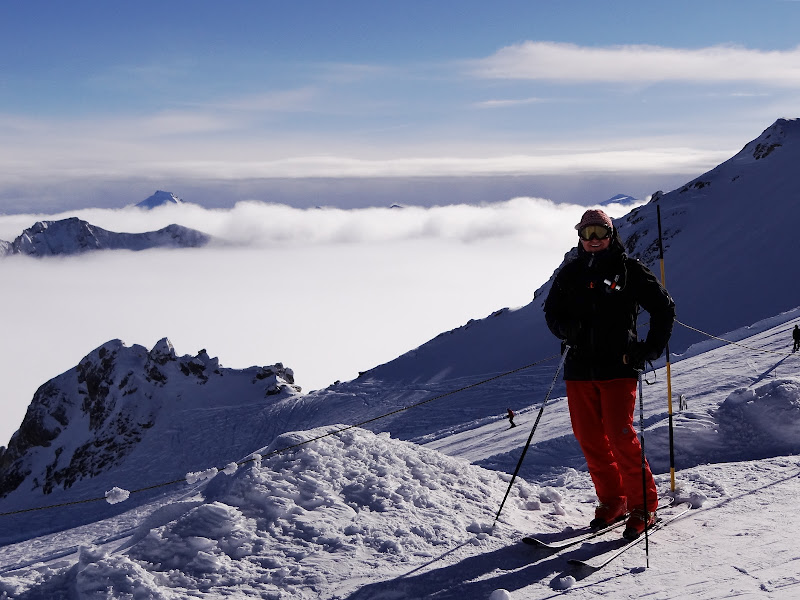If my hand got cold using the camera today it was because the temperature was -19°C. We were above the thermocline, where it should be warmer with the magnificent sea of clouds below us – but I was very glad of my thick down jacket! If fact I think it only really got down to -19°C when the thermocline rose up to this level a short while later and we were just inside the thin clouds. Mont Blanc in the background… 

 Haluk worked on ChiSkiing for improving hip angulation and to help to protect the lower back. He really started to get it in his skiing so that he could feel noticeably more free with turn initiation and pivoting off-piste, but not quite consistently enough to protect the back. It’s a coordination skill that takes time to develop and is linked to a progressive increase in bodily awareness – which only comes through persistence and practice. Haluk’s skiing is becoming much more direct in the fall-line and much more fluid, but needs a bit more control over speed – which is where the ChiSkiing will also help. Control over speed and line come largely from the ability to angulate and sink down into the turn – which can only be managed efficiently when the hip joints are relaxed and correctly positioned relative to the rest of the body. The re-alignment of the support hip at the very start of the turn makes entry into the turn much easier as it prevents the hip from travelling outwards thus impeding the motion of the centre of mass cleanly into the new turn – and eventually impeding angulation. Pulling the hip backwards also helps in keeping the feet placed relatively ahead of the hips and body. Haluk has also found that the seated stance in fall-line skiing is really helping – but this wasn’t possible until he started to use the pivot and stopped rotating around all the turns hard on the inside edges. Haluk mentioned that he had been trying to stop over-flexing at the ankles so I explained that the real issue was the hips. When flexion at the hips is blocked then the ankles will be used to compensate. The pulling backwards of the supporting hip – stretching the lower abdomen and lumbar area (instead of compressing) and moving the Lower/Upper body separation up to the 12 thoracic vertebra – allows angulation to take place correctly at the hip joint instead of at the lower back. The work on posture with both pelvic tilt – upwards – but only into “neutral pelvis” and the simultaneous relaxing of the hip joint and surrounding muscles is a pre-requisite to pulling the hip backwards and keeping it there through the turn. We used the “double pole touch” to the inside of the turn when carving to separate the Lower/Upper body in the desired manner.
Haluk worked on ChiSkiing for improving hip angulation and to help to protect the lower back. He really started to get it in his skiing so that he could feel noticeably more free with turn initiation and pivoting off-piste, but not quite consistently enough to protect the back. It’s a coordination skill that takes time to develop and is linked to a progressive increase in bodily awareness – which only comes through persistence and practice. Haluk’s skiing is becoming much more direct in the fall-line and much more fluid, but needs a bit more control over speed – which is where the ChiSkiing will also help. Control over speed and line come largely from the ability to angulate and sink down into the turn – which can only be managed efficiently when the hip joints are relaxed and correctly positioned relative to the rest of the body. The re-alignment of the support hip at the very start of the turn makes entry into the turn much easier as it prevents the hip from travelling outwards thus impeding the motion of the centre of mass cleanly into the new turn – and eventually impeding angulation. Pulling the hip backwards also helps in keeping the feet placed relatively ahead of the hips and body. Haluk has also found that the seated stance in fall-line skiing is really helping – but this wasn’t possible until he started to use the pivot and stopped rotating around all the turns hard on the inside edges. Haluk mentioned that he had been trying to stop over-flexing at the ankles so I explained that the real issue was the hips. When flexion at the hips is blocked then the ankles will be used to compensate. The pulling backwards of the supporting hip – stretching the lower abdomen and lumbar area (instead of compressing) and moving the Lower/Upper body separation up to the 12 thoracic vertebra – allows angulation to take place correctly at the hip joint instead of at the lower back. The work on posture with both pelvic tilt – upwards – but only into “neutral pelvis” and the simultaneous relaxing of the hip joint and surrounding muscles is a pre-requisite to pulling the hip backwards and keeping it there through the turn. We used the “double pole touch” to the inside of the turn when carving to separate the Lower/Upper body in the desired manner.
